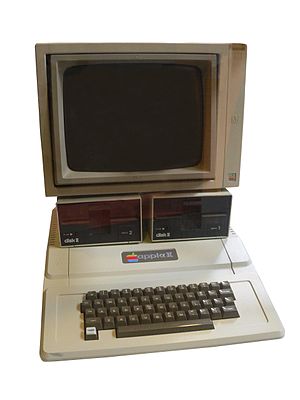Skip to comments.
FReeper Canteen ~ The Personal Computer Makes History! ~ 05 JUN 08
My Wee Widdle Bwain
| 05 JUN 08
| Old Sarge
Posted on 06/04/2008 6:04:28 PM PDT by Old Sarge
Welcome to the 05 JUN 08 edition of
The FReeper Canteen! The Personal Computer Makes History! |
|
On this day in 1977, the Apple II Personal Computer went on sale to the public, the first mass-produced microcomputer built by Apple, and one of the earliest and most successful home computers. By the end of its production in 1993, somewhere between five and six million Apple II series computers (including approximately 1.25 million Apple IIGS models) had been produced.
|
|
The first Apple II computers went on sale on June 5, 1977, with an MOS Technology 6502 microprocessor running at1 MHz, 4 KB of RAM, and an audio cassette interface for loading programs and storing data. The video controller displayed 24 lines by 40 columns of monochrome, upper-case-only text on the screen, with NTSC composite video output suitable for display on a monitor, or on a TV set by way of an RF modulator. The original retail price of the computer was $1,298 (with 4 KB of RAM) and $2,638 (with the maximum 48 KB of RAM). In 1978, an external 5¼-inch floppy disk drive, the Disk II created by Steve Wozniak, attached via a controller card that plugged into one of the computer's expansion slots and was used for data storage and retrieval to replace cassettes.  This was followed in 1983 by the Apple IIe, a cost-reduced yet more powerful machine that used newer chips to reduce the component count and add new features, such as the display of upper and lowercase letters and a standard 64 KB of RAM. Introduced with the IIe was the DuoDisk, essentially two Disk II 5¼-inch drives in a single enclosure designed to stack between the computer and the monitor, and a new controller card to run it. The DuoDisk was plagued by reliability problems, however, and did not catch on as well as the Apple IIe itself.  Apple released the Apple IIc in 1984, billing it as a portable Apple II, because it could be easily carried; however, it lacked battery power and a built-in display. The IIc even sported a carrying handle that folded down to prop the machine up into a typing position. Unlike previous Apple II models, the IIc had no internal expansion slots at all, this being the means by which its compact size was attained. Third parties did eventually figure out how to wedge up to 1 MB of additional memory and a real-time clock into the machine, and a later revision of the motherboard provided an expansion slot that could accept an Apple memory card bearing up to 1 MB of RAM.  The next member of the line was the Apple IIGS computer, released in 1986. A radical departure from the existing Apple II line, the IIGS featured a true 16-bit microprocessor operating at 2.8 MHz, allowing expansion up to 8 MB of RAM. It introduced two completely new graphic modes sporting higher resolutions and a palette of 4,096 colors; however, only 4 (at 640×200 resolution) or 16 (at 320×200 resolution) colors could be used on a single line at a time.  The final Apple II model was the Apple IIc Plus, introduced in 1988. It was the same size and shape as the IIc that came before it, but the 5¼-inch floppy drive had been replaced with a 3½-inch drive, the power supply was moved inside (gone was the IIc's "brick on a leash" power supply), and the processor was a fast 4 MHz 65C02 processor that actually ran 8-bit Apple II software faster than the IIGS. Unlike the IIe, IIc and IIGS, the IIc Plus came only in one, American, version, and was not officially sold anywhere outside the USA. .jpg/180px-Apple_IIc_Plus_(front).jpg)
Apple's Macintosh product line finally eclipsed the Apple II in the early 1990s. Even after the Macintosh's introduction, the Apple II had remained the company's primary revenue source for years: the Apple II and its associated community of third-party developers and retailers was once a billion-dollar-a-year industry. The computer was the first to attract a loyal user community and many outspoken Apple II fans were bitter that the company had invested its Apple II profits into the Macintosh rather than using them to further the Apple II series. Despite withholding advertising and little corporate support, Apple continued to sell the IIGS throughout 1992. Apple brought an era to a close when the IIe was removed from the product line on October 15, 1993. |
|
My very first PC in 1985 was the humble Apple IIc, on which I prepared DA and DD forms for the office on active duty. In 1991, I made the decision to migrate to the IBM PC that I built from scratch, and I've had twelve desktops and laptops in the house since then, including the Dell Inspiron that I took with me to OIF III. What memories do YOU have, of that first computer of yours? You know what they say: You never forget your first... |
|
|
FR CANTEEN MISSION STATEMENT ~ Showing support and boosting the morale of our military and our allies military and the family members thereof. Honoring those who have served before. Please remember: The Canteen is a place to honor and entertain our troops. The Canteen is family friendly, and please leave politics at the door. Let's have fun! |
|
TOPICS: Activism/Chapters; Free Republic; News/Current Events
KEYWORDS: canteen; troopsupport
Navigation: use the links below to view more comments.
first 1-20, 21-40, 41-60, 61-80 ... 341-347 next last
Come on back to the era of Stone Knives and Bear Skins!
1
posted on
06/04/2008 6:04:30 PM PDT
by
Old Sarge
To: Old Sarge
2
posted on
06/04/2008 6:05:05 PM PDT
by
ConorMacNessa
(HM/2 USN, 3/5 Marines, RVN 1969. St. Peregrine, patron saint of cancer patients, pray for us.)
To: Old Sarge
Good morning Troops, Veterans and Canteeners.* * * * * * * * * * * *
Our Flag Flying Proudly One Nation Under God
* * * * * * * * * * * *
Lord, Please Bless Our Troops, They're fighting for our Freedom.

I pledge allegiance to the Flag
of the United States of America,
and to the Republic, for which it stands;
one nation UNDER GOD,
indivisible,
with liberty and justice for all.
Prayers going up.
3
posted on
06/04/2008 6:05:14 PM PDT
by
HopeandGlory
(Hey, Liberals . . . PC died on 9/11 . . . GET USED TO IT!!!)
To: Old Sarge
4
posted on
06/04/2008 6:05:29 PM PDT
by
PROCON
(No more politics, I promise!)
To: Kathy in Alaska; StarCMC; MS.BEHAVIN; LUV W; HiJinx; mylife; PROCON; SevenofNine; TASMANIANRED; ...
5
posted on
06/04/2008 6:05:33 PM PDT
by
Old Sarge
(CTHULHU '08 - I won't settle for a lesser evil any longer!)
To: Old Sarge
6
posted on
06/04/2008 6:06:01 PM PDT
by
Tanniker Smith
(Teachers open the door. It's up to you to enter.)
To: Old Sarge; Kathy in Alaska; laurenmarlowe; MEG33; Mrs.Nooseman; alfa6; SandRat; HopeandGlory; ...
Greetings to all Canteen Denizens, Our Serving Military, Our Veterans, Their Families, FRiends and Our Allies!

Missing Man Setting

7
posted on
06/04/2008 6:06:05 PM PDT
by
ConorMacNessa
(HM/2 USN, 3/5 Marines, RVN 1969. St. Peregrine, patron saint of cancer patients, pray for us.)
To: ConorMacNessa
Welcome aboard, Conor! You’re FIRST tonight!
8
posted on
06/04/2008 6:06:09 PM PDT
by
Old Sarge
(CTHULHU '08 - I won't settle for a lesser evil any longer!)
To: HopeandGlory
Thank you for the Pledge tonight, Hope, and you’re also SECOND!
9
posted on
06/04/2008 6:06:36 PM PDT
by
Old Sarge
(CTHULHU '08 - I won't settle for a lesser evil any longer!)
To: Tanniker Smith
Hey there, Tanniker! Welcome to the thread, and you’re THIRD, too!
10
posted on
06/04/2008 6:07:03 PM PDT
by
Old Sarge
(CTHULHU '08 - I won't settle for a lesser evil any longer!)
To: Old Sarge

Freep mail me to be on or off the Daily Bread ping list
June 5, 2008
A Graduation Wish
Why are you cast down, O my soul? . . . Hope in God; for I shall yet praise Him. —Psalm 42:5
The high school commencement speaker was the president of a large corporation. He was chosen for the occasion because of his success. Yet his speech came with a most unusual wish for the graduates.
The speaker told the students sitting before him in their graduation gowns, “If I could have one hope for you as you go out into the world, it would be this: I hope you fail. I hope that you fail at something that is important to you.” He went on to say how his own early life had been one failure after another, until he learned to see failure as an effective teacher.
Many of the songs of Israel were born in seasons of failure. Out of desperation came the cry, “As the deer pants for the water brooks, so pants my soul for You, O God. My soul thirsts for God, for the living God” (Ps. 42:1-2).
Sometimes we are not ready to see the wonder of God’s wisdom and strength until we are gasping for breath in the exhaustion of our own strength.
A recurring story of the Bible is that mountains of faith rise from the valleys of failure. Before discovering the high ground we are looking for, we may need to see the failure of the dreams we hold in our hearts and trust instead in the love, wisdom, and guidance of our God.
The lessons we learn from our failures
Are lessons that help us succeed,
And if we are wise and we heed them,
Then failure is just what we need. —D. De Haan
11
posted on
06/04/2008 6:07:03 PM PDT
by
The Mayor
( In GodÂ’s works we see His hand; in His Word we hear His heart)
To: The Mayor
Thank you for the good word tonight, Your Honor! You’re also FOURTH!
12
posted on
06/04/2008 6:07:37 PM PDT
by
Old Sarge
(CTHULHU '08 - I won't settle for a lesser evil any longer!)
To: Old Sarge; All
To: Old Sarge
Thanks, Sarge! Glad to report for duty!

14
posted on
06/04/2008 6:07:57 PM PDT
by
ConorMacNessa
(HM/2 USN, 3/5 Marines, RVN 1969. St. Peregrine, patron saint of cancer patients, pray for us.)
To: Old Sarge
Thank you for the thread Sarge!
15
posted on
06/04/2008 6:08:26 PM PDT
by
The Mayor
( In GodÂ’s works we see His hand; in His Word we hear His heart)
To: laurenmarlowe
Lauren, you’re FIFTH tonight! Glad to see you, sweetie!
16
posted on
06/04/2008 6:08:51 PM PDT
by
Old Sarge
(CTHULHU '08 - I won't settle for a lesser evil any longer!)
To: ConorMacNessa
Great thread, Sarge - I remember my first PC had a 40 Meg Hard Drive. Now my little camera has a 4 gig memory card - amazing how far we've come in 20 years!

17
posted on
06/04/2008 6:10:30 PM PDT
by
ConorMacNessa
(HM/2 USN, 3/5 Marines, RVN 1969. St. Peregrine, patron saint of cancer patients, pray for us.)
To: Old Sarge; All

Chief Master Sgt. Earl McDonald speaks with his eldest son, Airman 1st Class Phil McDonald, March 13 upon his arrival to Sather Air Base, Iraq. Chief McDonald is the 447th Expeditionary Civil Engineer Squadron superintendent, and Airman McDonald is assigned to the 447th Expeditionary Security Forces Squadron. (U.S. Air Force photo/Tech. Sgt. Amanda Callahan)

Lt. Col. Russell Kaskel and Army Col. Jonathan Ives lead a group of more than 1,000 Panjshiris to where the new $6 million Barak to Khenj road will start construction May 28 in Barak of the Bazarak District of the Panjshir province in Afghanistan. The 18-kilometer, two-lane road is expected to be completed in March 2009. Colonel Kaskel is the Panjshir Provincial Reconstruction Team commander, and Colonel Ives is the Task Force Cincinnatus commander. (U.S. Air Force photo/Master Sgt. Demetrius Lester)

Jeff Knutson conducts phase maintenance on a U-2 May 23 at a Southwest Asian air base. Mr. Knutson is a 380th Expeditionary Aircraft Maintenance Squadron phase dock crew member. (U.S. Air Force photo/Senior Airman Levi Riendeau)
To: Old Sarge
My first computer was a Commodore 64! No skimping. I didn't get no stinkin' Vic 20. C64, baby!
For less than $100, I got a modem and that got me through college. Sometime after college, I bought a disk drive. Two, actually, because the first one wasn't 100% compatible. I spent over $100 for a disk drive mainly to play a single game that wouldn't run on the other one.
Ahhhh, fun times.
19
posted on
06/04/2008 6:10:54 PM PDT
by
Tanniker Smith
(Teachers open the door. It's up to you to enter.)
To: Old Sarge
Most of the computers in my friends' closets (and mine) are/were Commodore 64's and TRS-80's.
Still can't bear to throw them away even though they are no longer useful.
20
posted on
06/04/2008 6:11:05 PM PDT
by
capt. norm
(Never underestimate the power of very stupid people in large groups.)
Navigation: use the links below to view more comments.
first 1-20, 21-40, 41-60, 61-80 ... 341-347 next last
Disclaimer:
Opinions posted on Free Republic are those of the individual
posters and do not necessarily represent the opinion of Free Republic or its
management. All materials posted herein are protected by copyright law and the
exemption for fair use of copyrighted works.
FreeRepublic.com is powered by software copyright 2000-2008 John Robinson




.jpg/180px-Apple_IIc_Plus_(front).jpg)








